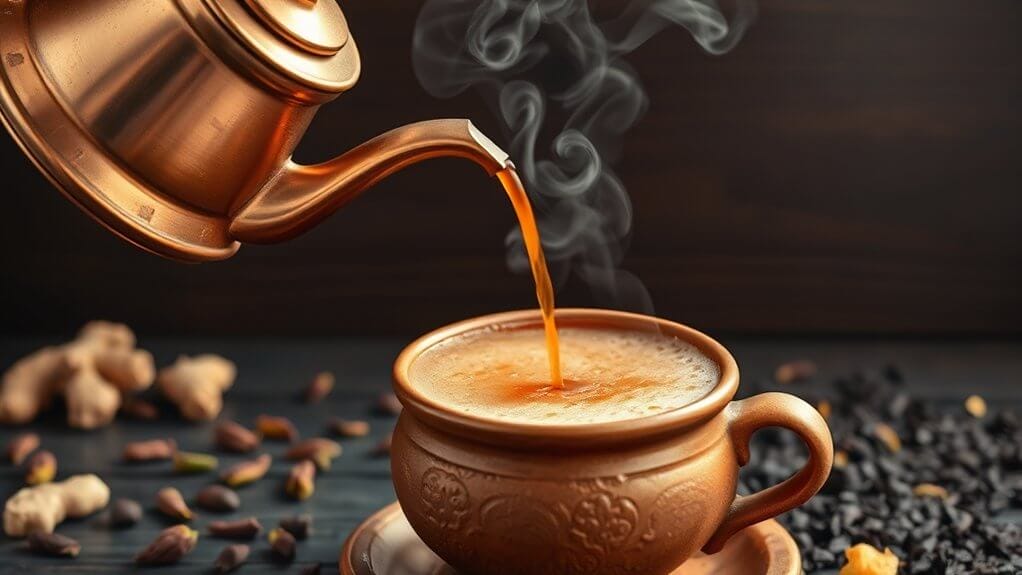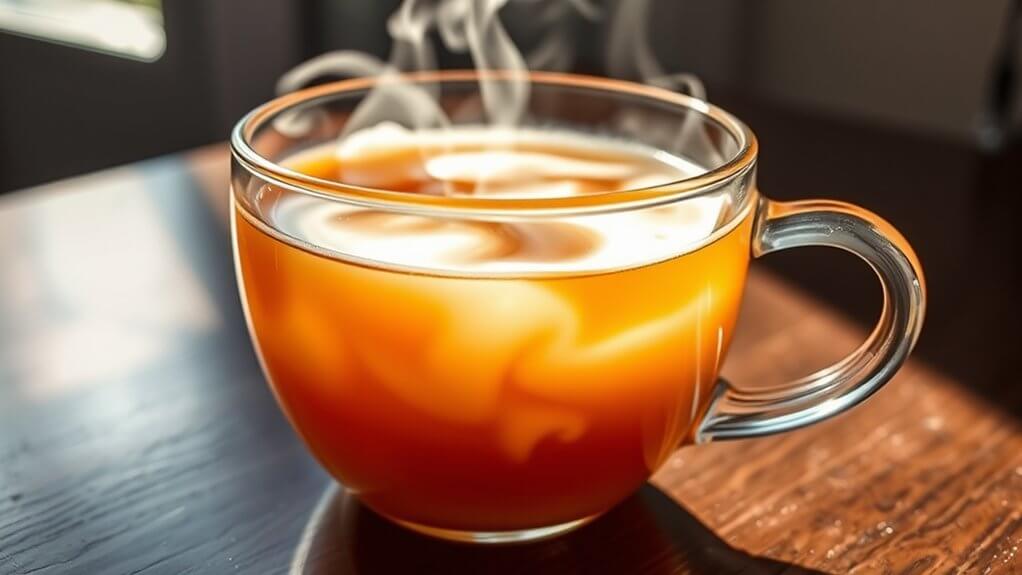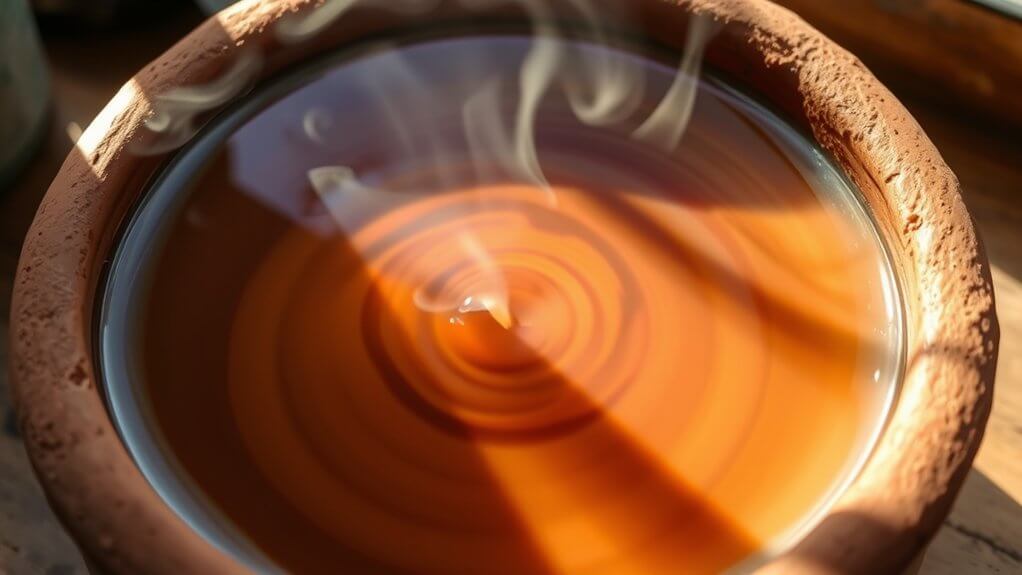Kadak chai's perfect strength and color emerge from meticulous brewing techniques and high-quality ingredients. The process starts with boiling water between 195-205°F, adding crushed spices and black CTC tea, followed by a precise milk-to-water ratio of 1:2. Constant stirring over low heat for 3-5 minutes creates the signature foamy bubbles and deep amber hue. The art of authentic Kadak chai lies in mastering these essential elements that transform simple ingredients into a rich, aromatic experience.
Key Points
- Use quality Assam or Ceylon CTC black tea and maintain a brewing temperature between 195-205°F for optimal flavor extraction.
- Steep tea leaves for exactly 2 minutes, followed by 3-5 minutes of simmering with spices for robust flavor development.
- Maintain a milk-to-water ratio of 1:2 and stir constantly over low heat until foamy bubbles appear.
- Choose fresh whole spices like cardamom, cloves, and cinnamon, crushing them just before brewing for maximum aroma impact.
- Allow initial boiling for 30-40 seconds to prevent bitterness, then strain thoroughly to achieve a clean, deep amber color.
Understanding the Core Elements of Kadak Chai

Kadak chai, a robust and flavorful Indian tea, draws its distinctive character from a carefully selected blend of aromatic spices. The traditional recipe combines cardamom, black pepper, cloves, fennel seeds, and cinnamon, each contributing unique qualities to create a harmonious and invigorating beverage. These spice combinations not only enhance the taste but also provide numerous health benefits. Using plant-based milk can create an equally delicious vegan version of this traditional drink.
The carefully chosen spices work together to improve digestion, fight common illnesses, and deliver anti-inflammatory effects. Cardamom and cinnamon offer antibacterial properties, while black pepper and fennel seeds aid in digestive health. When properly prepared through a methodical process of boiling, simmering, and steeping, these ingredients release their full potential. For optimal results, grating fresh ginger directly into the simmering water intensifies the flavor profile. While regional variations exist in spice ratios and preparation methods, the core elements remain consistent in creating this beloved beverage. This versatile beverage has gained widespread popularity in Indian and Arabic regions due to its unique flavor profile.
Essential Tools and Ingredients for Perfect Brewing

To create the perfect cup of Kadak chai, specific tools and premium ingredients work together as the foundation for an authentic brewing experience. Essential brewing accessories include insulated tea brewers, temperature-controlled kettles, and precise kitchen scales for maintaining consistent ingredient ratios. Manual or electric timers help achieve ideal steeping times, while recipe journals track successful variations. The term "karak means strong" reflects the bold and robust nature of this beloved beverage. Setting the water temperature to 190-200 degrees Fahrenheit ensures optimal flavor extraction without unwanted bitterness.
Quality black teas from Assam, Ceylon, or Kenya form the base, while cardamom pods and saffron add distinctive warmth and color. The addition of evaporated milk or sweetened condensed milk creates the signature creamy texture. When using dairy milk, boil it separately before combining with the spiced tea to prevent curdling. For unique variations, fresh ginger, black pepper, wild cinnamon quill, Kandyan cloves, and Hariyali fennel can enhance the traditional recipe. Proper equipment features like manual fill options and effective insulation guarantee the chai maintains its desired temperature and flavor throughout service.
Mastering the Brewing Technique

Mastering the art of brewing Kadak chai requires careful attention to timing, temperature, and technique. The process begins with boiling water and adding crushed spices, followed by tea leaves that steep for up to two minutes. Different spice variations, from classic cardamom to exotic saffron, can create unique flavor profiles. Using fresh whole spices enhances the authentic aroma and flavor of the chai significantly.
The key to achieving the perfect brew lies in the proper ratio of ingredients and careful temperature control. Adding milk – whether whole, reduced-fat, or plant-based milk types – should follow a 1:2 ratio with water. Using low heat brewing ensures a richer and more complex flavor development. It's essential to avoid common pitfalls like overheating or insufficient infusion time. For the best results, let the mixture simmer on low heat for 3-5 minutes, allowing the flavors to meld together. A fine strainer guarantees a smooth finish, while sugar can be adjusted to taste.
The Role of Timing and Temperature

While brewing the perfect cup of Kadak chai requires careful attention to multiple factors, timing and temperature stand out as the most vital elements. The ideal brewing temperature hovers just below boiling point, around 195-205°F, ensuring the best flavor extraction without scorching the tea leaves. Using an electric kettle with sensors can help maintain precise temperature control throughout the brewing process. The popular combination of black tea with spices has been a cherished tradition since the 1800s when British tea practices influenced Indian brewing methods.
The steeping duration plays a significant role in achieving Kadak chai's signature robust taste. Initially, the tea leaves should be briefly boiled for 30-40 seconds before adding milk to prevent bitterness. Once milk is added, the mixture needs constant stirring over low heat until foamy bubbles appear. This process typically takes 6-10 minutes, allowing the flavors to meld perfectly. The traditional method of combining tea leaves, spices, and milk on the stovetop demands vigilant monitoring to prevent overflow while ensuring the mixture thickens to the desired consistency. For the richest texture and most satisfying experience, allow the tea to settle before straining.
Unlocking Rich Colors and Textures

Beyond the precise timing and temperature, the rich visual appeal of Kadak chai emerges from its carefully selected ingredients and preparation methods. Color infusion primarily depends on the choice of black tea, with Assam tea delivering the desired deep amber hue that's characteristic of authentic Kadak chai. Saffron threads contribute subtle golden undertones, while evaporated milk adds creamy complexity. The full-bodied and strong characteristics of the tea make it particularly comforting during stressful times or cold weather. The addition of condensed milk creates an exceptional richness that distinguishes this beverage from other tea varieties.
Texture enhancement relies heavily on proper milk integration and brewing techniques. The traditional method of aerating the tea by ladling it from a height creates a silky smoothness, while simmering helps develop the perfect thickness. When combined with aromatic spices like cardamom, cinnamon, and cloves, these elements work together to create a visually striking and texturally satisfying beverage that's become a hallmark of South Asian tea culture.
Troubleshooting Common Kadak Chai Challenges

Although making Kadak chai requires skill and attention to detail, even experienced tea makers encounter common challenges that can affect the final product. Understanding bitterness balance starts with proper spice proportions and careful monitoring of steeping time, while weakness remedies often involve adjusting the tea-to-water ratio and using high-quality ingredients. Using black CTC tea provides the strongest and most authentic flavor profile for traditional Kadak chai preparation. The beverage's taste can be further enhanced by adding natural sweeteners like jaggery or honey.
Common lumps causes include improper stirring techniques and incorrect handling of milk, particularly when using condensed varieties. Straining the tea properly and crushing whole spices help prevent unwanted sediment. For scalding prevention, it's essential to use the right-sized saucepan and maintain appropriate heat levels, especially after adding milk. Different milk types can behave differently during heating, so adjusting the temperature accordingly helps avoid boil-overs and guarantees a smooth, perfectly brewed cup of Kadak chai.
Conclusion
Brewing kadak chai is like conducting a symphony where every element must harmonize perfectly. With the right balance of ingredients, precise timing, and proper technique, anyone can master this beloved beverage. While challenges may arise, understanding the core principles and practicing consistently will lead to that ideal cup – rich in color, bold in flavor, and carrying that signature strength that defines true kadak chai.

